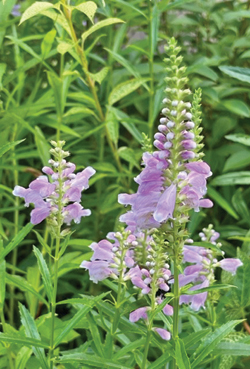September Plant of the Month: Obedient Plant
Submitted by the Bath Gamma Garden Club
Members of the Bath Gamma Garden Club visited the Cleveland Botanical Gardens on a recent summer evening. Exiting the woodland path walkway, the group came into a planting of sweet smelling Clethra along with a robust patch of physostegia virginiana, orobedient plant. It was a heavenly combination like sweet honey and mint that filled the air. It was refreshing for late summer when there are not so many flowers in bloom.
Obedient plant, also known as false dragonhead, is a flowering plant in the mint family that is easy to grow. True to its name, the plant’s individual flowers are “obedient” and can bend in any direction and will temporarily stay in place. Unfortunately, this fast-growing perennial is not so obedient in the garden, where it can spread quite aggressively by rhizomes. Its other common name, false dragonhead, likely came about because of the flowers’ resemblance to snapdragons.
Obedient plant is native to North America and attracts pollinators such as bees and hummingbirds. It is resistant to deer. Tubular, two-lipped, snapdragon like flowers form on the plant’s upright terminal spikes, each about 12-18 inches, and open from the bottom up in shades of pink, lilac and white from late June-September. The overall mature size is 3-4 feet tall and 2-3 feet wide.
The best conditions for growing obedient plant include full sun exposure for the most blossoms, however they can manage partial shade. They prefer well-drained soil that is slightly acidic. Water once or twice a week depending on the conditions. Once established, they are drought tolerant plants. They are reliably hardy in USDA zones 3-10. Do not fertilize obedient plants unless they show signs of nutrient deficiencies. Less fertilizer means less aggressive spreading. Rust can be an occasional problem. Watch for aphids and spider mites.
Seed can be directly sown in the ground in late fall and have a germination rate of nearly 100%. When the clumps thin out in the center and take on an open floppy form, they are telling you it is time to divide them. Existing clumps should be divided and transplanted in early spring.
The biggest maintenance chore is keeping the obedient plant from rampant spreading. They do pull out easily. Do not let them go to seed. Divide and share the plants.
The flowers of the obedient plant are showy and make a good cut flower. They combine well with blue flowers of the late summer garden such as caryopteris, Russian sage, catmint and ironweed. The spikey flowers are also a nice contrast with asters, sedum and coneflowers. They fit with various garden styles such as cottage gardens, wild native gardens, prairies, or meadows.
So, there is more to the late summer garden than one previously thought if you just think outside the box of mums. Although, who can resist the beautiful colors of fall mums?
For information on sources and availability of obedient plant and other native perennials, email bathgammagardenclub@gmail.com. ∞
Photo: Physostegia virginiana, commonly known as Obedient Plant. Photo by Pam Reitz.

